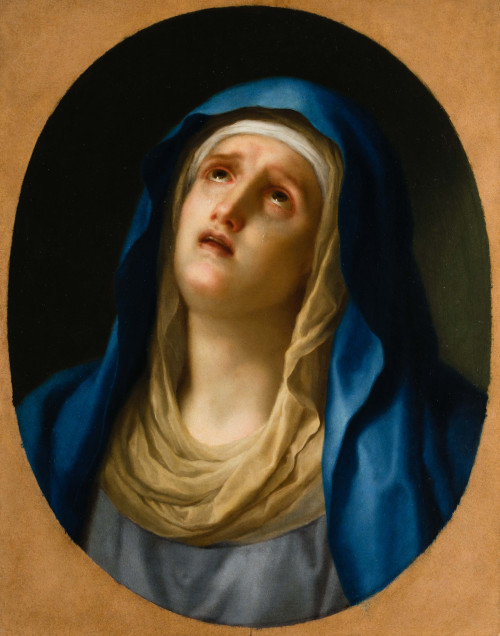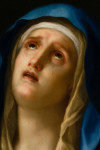Lot 225
ANTON RAPHAEL MENGS Aussig, Bohemia, (1728) / Rome, Italy (1779) "Mater Dolorosa", c. 1778-1779
Oil on walnut panel.
Provenance:
- Madrid, collection of Don Antonio de la Cuadra (1780);
- Madrid, collection of Dolores de Alcober, Dowager Marchioness of Castañeda (1929);
- Madrid, private collection.
Bibliography: Azara, N., Works of D. Antonio Rafael Mengs, painter of the King's Chamber, 1780, S. XLVIII; Bianconi, GL, Elogio storico del Cavaliere Anton Raffaele Mengs, con un Catalogo delle opere da esso fatte, Milan, 1780, oS, 91; Doray de Longrais, JP, Oeuvres de M. Mengs, 1782, 5.32; Jansen, H., Oeuvres complètes d'Antoine-Raphaël Mengs, premier peintre du roi d'Espagne, 1786, I, p. 62; Azara, N. and Fea, C., Opere di Antonio Raffaello Mengs primo pittore del re cattolico Carlo III, 1787, XLIV; Sánchez-Cantón, FJ, Antonio Rafael Mengs (1728-1779), 1929, no. 54, p. 29; Honisch, D., Anton Raphael Mengs und die Bildform des Frühklassizismus, Recklinghausen, 1965, no. 167; Roettgen, S., Anton Raphael Mengs 1728-1779, Munich, 1999, I, early 82-83, no. 48.
Anton Raphael Mengs exerted a great influence on Spanish art and his mark can be seen in the production of several painters from the court circle such as: Francisco Bayeu, Mariano Salvador Maella or Francisco de Goya himself. He was at the service of Charles III from 1761 until his death in 1779 and as the first painter from October 22, 1766. His presence in Spain took place in two stages: a first between September 1761 and November 1769 and a second in July from 1774 to January 1777. The panel presented here is formally related to one of his most emblematic works: The Lamentation over the Dead Christ (National Heritage, inv. number 10084136), executed in the last two years of his first stay in Spain; a painting that was part of a cycle made by the artist for the decoration of the bedroom of Charles III in the Royal Palace of Madrid. As can be seen by comparing the two works, this Mater Dolorosa, which in the past belonged to the collection of Don Antonio de la Cuadra, precisely follows the same model as that of the Virgin of Lamentation. It shows Mary represented as a bust with a gesture torn by her pain, her face reddened and full of tears, directing her gaze to heaven with a clear interpellation attitude. She wears a white cap and carries an ocher scarf that frames her face and neck, wearing a grayish tunic that appears covered by the splendid blue cloak. As Hornisch pointed out, this painting must be the same one that, according to Azara's testimony, belonged to the collection of Don Antonio de la Cuadra, general director of the Post Office, who commissioned Mengs himself to execute it. According to Azara, the wooden panel had an oval frame and had dimensions of two feet and a finger high by a foot and a half wide; measurements that coincide exactly with those of this work. Sadly, its original frame was lost in the mid-20th century at the time it changed ownership. The composition of this Mater Dolorosa by Mengs enjoyed great success and proof of this is that the engraver Fernando Selma (Valencia, 1752 - Madrid, 1810) took the model to take it for printing, although in said work no reference is made to the author of the original painting, since only the inscription appears: “Fernando Selma drew and engraved it.” The engraver José Gómez de Navia (San Idelfonso, Segovia, 1757 - Madrid, ca. 1803) made a similar version, according to the design made by José López Enguídanos, inspired by the original painting. Mengs also painted a second version of this Dolorosa for the architect Francesco Sabatini, but smaller, 30 x 30 cm, and with a quadrangular format. Honisch identified Sabatini's painting with one located in the Royal Academy of History in Madrid and which is also a partial replica of the model that appears represented in the Lamentation of the Royal Palace of Madrid.
Measurements: 61 x 48 cm.
Starting price 18.000 €
Recomended lots
Confirm
You are bidding €
At the time of auction we will contact you by phone:
You accept the conditions of the room by confirming your bid
Loading…
Conecting with the server
Are you sure you want to buy the lot?







